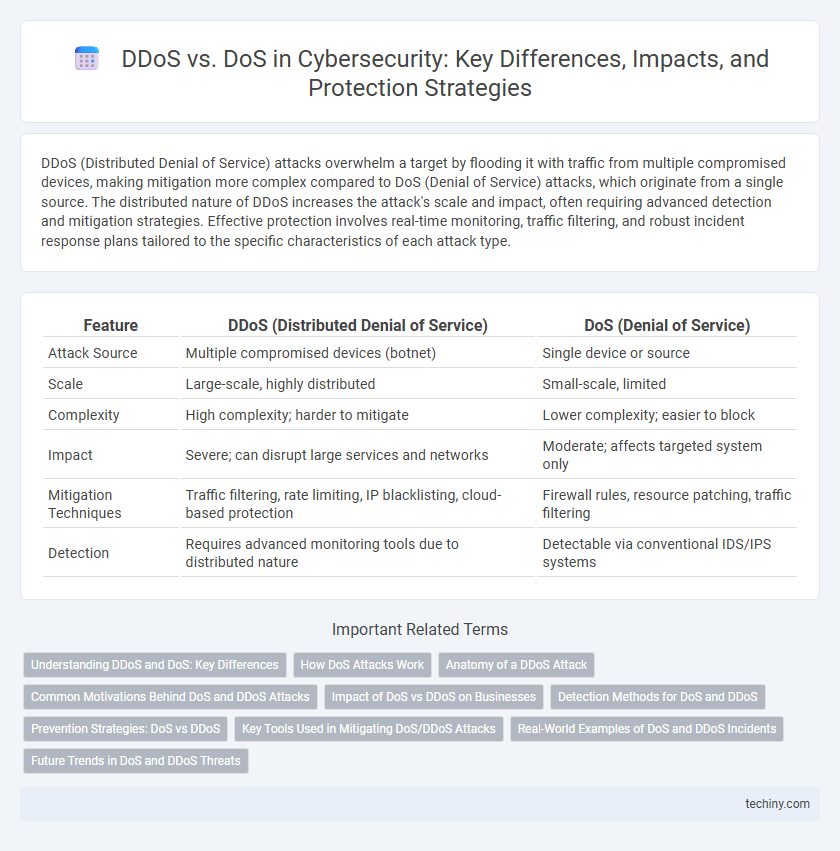DDoS (Distributed Denial of Service) attacks overwhelm a target by flooding it with traffic from multiple compromised devices, making mitigation more complex compared to DoS (Denial of Service) attacks, which originate from a single source. The distributed nature of DDoS increases the attack's scale and impact, often requiring advanced detection and mitigation strategies. Effective protection involves real-time monitoring, traffic filtering, and robust incident response plans tailored to the specific characteristics of each attack type.
Table of Comparison
| Feature | DDoS (Distributed Denial of Service) | DoS (Denial of Service) |
|---|---|---|
| Attack Source | Multiple compromised devices (botnet) | Single device or source |
| Scale | Large-scale, highly distributed | Small-scale, limited |
| Complexity | High complexity; harder to mitigate | Lower complexity; easier to block |
| Impact | Severe; can disrupt large services and networks | Moderate; affects targeted system only |
| Mitigation Techniques | Traffic filtering, rate limiting, IP blacklisting, cloud-based protection | Firewall rules, resource patching, traffic filtering |
| Detection | Requires advanced monitoring tools due to distributed nature | Detectable via conventional IDS/IPS systems |
Understanding DDoS and DoS: Key Differences
DDoS (Distributed Denial of Service) attacks utilize multiple compromised devices to overwhelm a target system, causing widespread disruption, whereas DoS (Denial of Service) attacks originate from a single source, making them easier to mitigate. The scale and complexity of DDoS attacks require advanced mitigation strategies, including traffic filtering and anomaly detection, to protect network infrastructure effectively. Understanding these key differences is crucial for cybersecurity professionals to develop robust defense mechanisms against evolving online threats.
How DoS Attacks Work
DoS attacks overwhelm a target system by flooding it with excessive traffic or exploiting vulnerabilities to exhaust its resources, causing service disruptions. These attacks typically originate from a single source, limiting their scale but making them easier to detect and mitigate. The primary goal of a DoS attack is to deny legitimate users access to the targeted network, server, or application.
Anatomy of a DDoS Attack
A DDoS (Distributed Denial of Service) attack overwhelms a target by flooding it with traffic from multiple compromised devices, creating a massive volume of data that exhausts bandwidth and server resources. Unlike a DoS (Denial of Service) attack, which originates from a single source, the distributed nature of DDoS makes detection and mitigation more complex due to the simultaneous assault from numerous IP addresses. Key components in the anatomy of a DDoS attack include the botnet of hijacked devices, command and control servers that orchestrate the attack, and the attack vectors such as volumetric, protocol, and application layer attacks designed to disrupt specific network functionalities.
Common Motivations Behind DoS and DDoS Attacks
DoS and DDoS attacks primarily stem from motivations such as financial gain, competitive sabotage, and ideological agendas, including hacktivism. Cybercriminals exploit these attacks to disrupt services, demand ransoms, or damage the reputation of targeted organizations. Understanding these common motivations aids in developing proactive defense strategies against evolving cybersecurity threats.
Impact of DoS vs DDoS on Businesses
DoS attacks disrupt business operations by overwhelming a single system or network resource, leading to temporary downtime and lost revenue. DDoS attacks exponentially amplify this damage by coordinating multiple compromised devices, causing widespread outages that can cripple an entire organization's online presence. The extended disruptions from DDoS attacks result in severe financial losses, reduced customer trust, and long-term reputational harm compared to the more isolated impact of DoS attacks.
Detection Methods for DoS and DDoS
Detection methods for DoS and DDoS attacks rely on traffic analysis techniques such as anomaly detection, signature-based detection, and behavior-based monitoring to identify unusual spikes or patterns indicating malicious activity. Network intrusion detection systems (NIDS) and advanced machine learning algorithms enhance detection accuracy by correlating multiple data sources, including packet rates, source diversity, and traffic volume anomalies. Real-time monitoring tools equipped with threshold-based alerts and pattern recognition play a critical role in timely identifying and mitigating both DoS and DDoS threats.
Prevention Strategies: DoS vs DDoS
DoS prevention strategies focus on monitoring and limiting traffic from single sources using rate limiting, firewall rules, and server resource management to block or absorb attack traffic. DDoS defense requires more advanced techniques such as traffic filtering through scrubbing centers, deployment of Intrusion Prevention Systems (IPS), and the use of Content Delivery Networks (CDNs) to distribute traffic and mitigate large-scale, multi-source attacks. Both require continuous network monitoring and rapid incident response, but DDoS protection emphasizes scalability and redundancy to handle the distributed nature of attacks.
Key Tools Used in Mitigating DoS/DDoS Attacks
Key tools used in mitigating DoS and DDoS attacks include firewalls, intrusion detection systems (IDS), and rate limiting mechanisms that help filter malicious traffic. Content Delivery Networks (CDNs) and cloud-based DDoS protection services like AWS Shield and Cloudflare provide scalable defense by dispersing traffic across multiple servers. Behavioral analytics and AI-driven systems enhance detection accuracy by identifying anomalies and stopping attacks before significant damage occurs.
Real-World Examples of DoS and DDoS Incidents
The 2016 Dyn cyberattack exemplifies a large-scale DDoS incident, disrupting major websites like Twitter, Amazon, and Netflix by overwhelming DNS servers with massive traffic from the Mirai botnet. In contrast, the 2013 Spamhaus DoS attack targeted a single organization, aiming to cripple its infrastructure with a high volume of traffic but on a relatively smaller scale than DDoS. These real-world cases highlight the varying impacts of DoS and DDoS attacks, with DDoS leveraging distributed networks of compromised devices to amplify disruption.
Future Trends in DoS and DDoS Threats
Future trends in DoS and DDoS threats indicate increasing sophistication with the rise of AI-driven attacks capable of bypassing traditional mitigation techniques. The proliferation of IoT devices enhances botnet scale and attack volume, amplifying the impact on targeted networks. Emerging defense mechanisms leveraging machine learning and behavioral analytics aim to detect and neutralize complex attack patterns in real-time.
DDoS vs DoS Infographic

 techiny.com
techiny.com